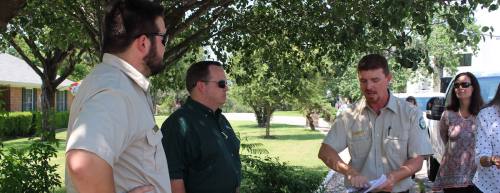The cities of Rollingwood and West Lake Hills jointly hosted their second annual symposium June 23 to discuss oak wilt, a contagious disease that can kill both live and red oak trees.
“Our goal was to have a community conversation about oak wilt and how we can best improve our efforts to contain this disease and make our residents more aware of how they can stop it,” West Lake Hills Mayor Linda Anthony said. “It is a community-wide issue that no single jurisdiction can manage on its own.”
Representatives from the city of Austin, Barton Creek West neighborhood, Texas A&M Forest Service, Travis County, Village of Briarcliff, Village of The Hills, and Water Control & Improvement District 10 were also in attendance.
Recent efforts
 West Lake Hills and WCID 10 shared the cost of a $600,000 project on Westwood Terrace to create a 2,000-foot-long trench between the city and an oak wilt center in the Travis County development of Westwood, Anthony said. The project, which dug a trench to install a new water line under the road that doubles as an oak wilt trench, was completed in May.
West Lake Hills and WCID 10 shared the cost of a $600,000 project on Westwood Terrace to create a 2,000-foot-long trench between the city and an oak wilt center in the Travis County development of Westwood, Anthony said. The project, which dug a trench to install a new water line under the road that doubles as an oak wilt trench, was completed in May.
“The water line wasn’t supposed to be installed for another three years, but I’m happy to say WCID 10 went ahead and got the work approved,” she said. “We hope that will be a big impediment to the spread of oak wilt into West Lake Hills."
Anthony said the city has had as many as 11 active oak wilt centers in the past, but due to trenching over the past 20 years, that number is down to three disease centers.
“That’s a great indication that trenching does work,” she said.
However, one of the three oak wilt centers is new, located near a previously identified dormant site on North Peak Road and spreading toward Rollingwood, she said. Area trees are actively being injected with fungicide, and she said the city hopes trenches from water projects completed in 2013 will act as barriers to the disease.
Rollingwood spent $140,000 in March trenching a total of 3,300 feet to limit a separate outbreak of oak wilt that had been identified on 11 residential properties, Rollingwood Mayor Roxanne McKee said.
The city contacted Clay Bales, a Texas A&M Forest Service forester, before planning the project. Bales recommended trenching through the street and on residential properties to create a closed loop around the infected area, she said.
“The process [of trenching] was challenging, expensive and time-consuming, but it was worth it because hopefully we saved a lot of oak trees and contained the disease,” McKee said. “It really stressed to me how important it is to catch the disease as early as possible before it becomes a project of that size.”
Barton Creek West, a Travis County development off Bee Caves Road, also trenched on residential properties when its residents noticed oak wilt, said Beth Kirkhart, a member of the Barton Creek West Board of Directors. The community injected fungicide into healthy trees on the properties and removed trees near the trench while destroying roots with herbicide as extra precautionary measures, she said. 
Tracking oak wilt centers
Austin is aware of 321 oak wilt centers within its city limits, with 100 centers identified as active, city Urban Forester Emily King said.
To better track the disease’s movement, Josh Rudow, conservation program coordinator in the city’s tree preservation division, said Austin is creating a database with maps, photos and information on each oak wilt center. An inventory of all known centers will be completed by the end of the year, and active centers will be visited and updated at least once in the next three years, he said.
Locations that are being injected will be evaluated 18 months after the treatment, and trees near trench projects will be reviewed a year after the project’s completion, he said.
Rudow said he believes making locater maps available to the public would be a great tool to allow residents to take preventive actions on their own properties. However Austin, as well as West Lake Hills and Rollingwood, has held off publishing oak wilt maps due to privacy concerns, he said.
“Some residents are very concerned with being labeled an oak wilt site because they’re worried about property values and privacy,” Anthony said. “One of West Lake Hills’ goals is to get our maps online because our residents need to know where the disease is and where it might be heading. It’s a very fine line.”
Bales said cities do not have the ability to track every single tree, and most maps only estimate the location where oak wilt is believed to be present.





